#dementors and the minister are gonna be after him any second and harry and hermione are yelling at him to GO
Note
WHAT'S THE CAUSALITY LOOP THEORY
Why Emma, thank you so much for asking. I’m not going to waste time before jumping into this because this is gonna get long so without further ado...
Steve Rogers’ Ending and How Endgame Doesn’t Support a Causality Loop
and other such rambles
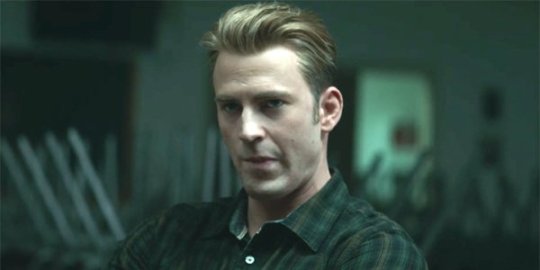
Last month, I came across a TikTok that proposed that Steve’s ending made sense because it existed within a causality loop. I would link the TikTok but I didn’t save it at the time and trying to find videos on that app is impossible. You think Tumblr’s search function is bad? 🙄 But I digress. The TL;DR of the video is that due to time travel and Steve choosing to go back in time to be Peggy’s husband, it created a causality loop where he was always meant to be her husband because he went back in time and stayed there. The TikToker supported his argument by using Harry Potter and the Prisoner of Azkaban (PoA), another film that uses time travel and has a clearly defined example of a causality loop. However, his argument is fundamentally flawed so I’m going to combine my knowledge of my two biggest fandoms to tell you why.
Continued under the cut because I have no chill. Beware, it's long.
To first tell you how Endgame (EG) doesn’t support a causality loop, we must establish how PoA does establish one and does it successfully. The TikToker specifically mentions the scenes that take place at Hagrid’s Hut surrounding Buckbeak the hippogriff’s execution, so we’ll look at those first. What the film does really well is establish early on that there is something weird going on well before anyone actually goes back in time. There are three things that happen in quick succession during this scene which sets up the causality loop we see later in the film. First, a rock flies through the window and breaks a jar. Second, another rock hits Harry in the back of the head. Third, once outside, Hermione hears a branch snap and thinks she sees ‘something’. There are also two additional moments later on in the film once the Harry, Ron, and Hermione have come out of the Shrieking Shack which should also be noted: a wolf howl that distracts Remus Lupin in werewolf form from attacking the group and somebody casting a full-bodied stag patronus at the edge of the lake to save Harry and Sirius from the Dementors.
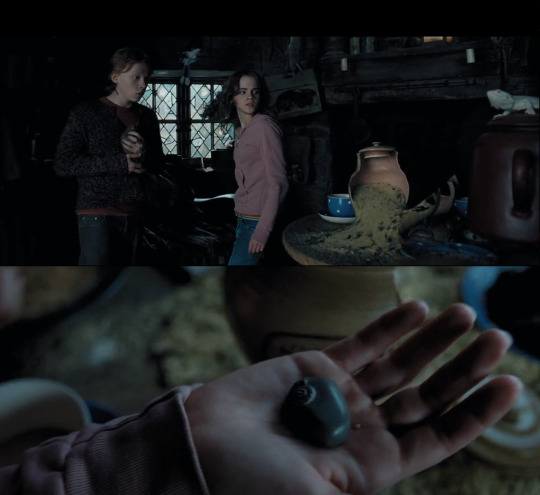
Of these occurrences, the first is arguably the most important because it does the most to establish that there is something going on outside of the Trio’s current understanding of their situation. The film makes a point to frame the jar breaking as Important Information the Audience Must Remember because it shows a visibly confused Hermione reacting to it as she picks up the rock for closer inspection and we the audience are given close up of it in her hand. Not only is it framed front and centre in the shot but the rock itself is very distinctive. It’s almost wholly smooth but for a swirl of fossil, thus marking it as not just any rock but An Important Rock To Be Remembered. This was an intentional choice by director Alfonso Curon because he uses this rock to connect this moment to its mirrored scene later on once Harry and Hermione use the Time Turner.
The audience and the characters find out about the causality loop at the same time. There are clearly stated rules of time travel that say that they aren’t to meddle with time but when Harry and Hermione see that Dumbledore, the Minister for Magic, and the executioner are on their way to Hagrid’s hut they panic because their counterparts aren’t leaving. Then, we see Hermione notice something in the pumpkin patch: a distinctive rock, smooth with a swirl of fossil. Again, we see have a close up shot with the rock centred to show its importance. Stylistically, it’s very similar to the shot we saw earlier in the film which gives the audience an emotional pay off for noticing the connection. When Hermione throws the rock and breaks the jar, it sets the causality loop in motion. The jar was always going to break because they went back in time to throw the rock that breaks it.
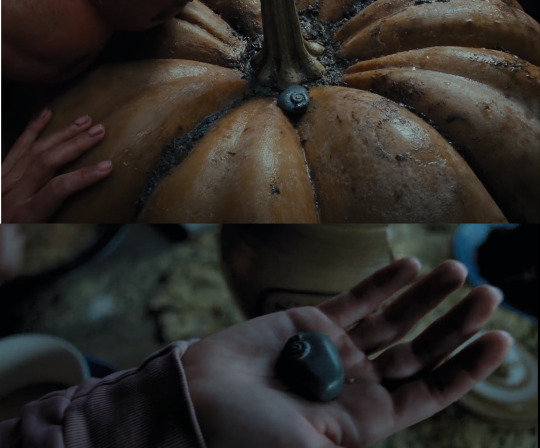
And it’s the same with all the other instances. Hermione throws the second rock that hits Harry in the back of the head to alert him to the fact they need to get out of the hut. Hermione snaps the branch and is almost seen by her counterpart in the past. Hermione makes the wolf call to distract Lupin from attacking. Harry, and not his father as he had assumed, casts the patronus to save himself and Sirius from the Dementors. But each of these moments are set up clearly in the ‘first run through’ to set up their payoff when the characters realise, ‘Oh, I did these things. They were always meant to happen.’ From a narrative standpoint, these are planned out moments to clue the audience into the fact that there’s something bigger at play. It keeps them ‘in the loop’ as it were.
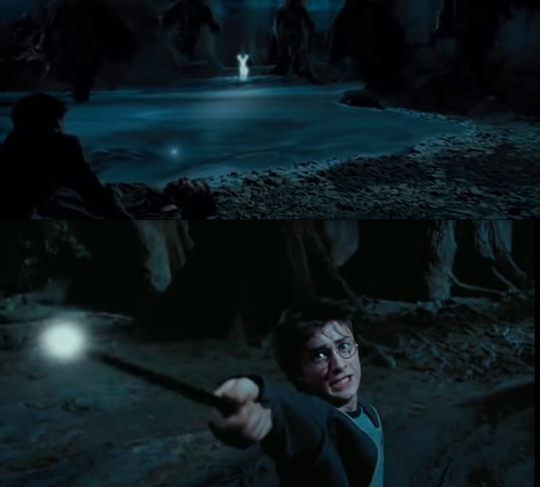
This doesn’t happen in EG.
To successfully have set up a causality loop that made sense and had the same kind of set up and pay off as we see in PoA, it would have had to have been established as early as 2014 in Captain America: The Winter Soldier (CA:TWS). This does not happen. One of the main themes of CA:TWS is moving on from the past. Peggy Carter herself even says, “I’ve lived my life, my only regret is that you didn’t get to live yours.” Then saying soon after, “Sometimes the best thing we can do is to start over.” Peggy’s character in Captain America: The First Avenger is set up as someone who acts as the backup/back bone of Steve’s own moral compass. When Steve falters at Azzano about what to about the captured 107th, Peggy is there to remind him of what is right. She serves a similar narrative function in CA:TWS. Steve is struggling with life in the present. He’s just seen the helecarriers and argued with Nick Fury about protection vs fear after the botched Lumerian Star mission. Morally, he’s in turmoil and has turned to Peggy for council because he’s trying to find purpose in world where his rigid morality seems to have no place.
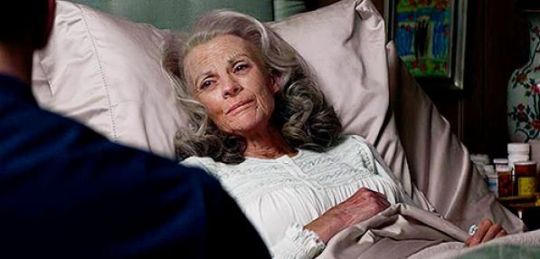
From the point of view of creating a causality loop, one would think that this scene in the hospital would be the place where an initial set-up could be made and alert the audience to the long term plan for Steve’s character. Instead, we have Peggy mourning the fact that Steve didn’t get to live his life the way it should have played out, and why would a woman who has supposedly been married to another version of Steve tell him to move on? In addition, when Steve visits the Smithsonian, he watches a video where he sees Peggy talking about how he influenced her life and how during one of his missions, he saved the man that would go on to become her husband. This is the only mention of Peggy’s husband in the entire franchise until Steve reappears as an old man at the end of EG.
Captain America: Civil War (CA:CW) also offers an opportunity to set up the causality loop at Peggy’s funeral but again, this does not happen. The only family we are introduced to is Sharon Carter, Peggy’s grand-niece. When it comes to filmmaking, every choice made is intentional. From the hair and makeup to the clothes, to the music used, everything in a film means something whether it is to further character development, world-building, or the plot. Filmmakers have a limited amount of time to convey a story and anything that doesn’t matter isn’t shown. Therefore, we can conclude from the text of the film that Peggy’s husband doesn’t matter to the narrative. The person in Peggy’s family who matters to the narrative is Sharon Carter which is why she is given prominence during CA:CW’s funeral scene. Had the causality loop been set up here, there would have been a defining moment like in PoA where the audience is clued into the larger story arc. Maybe someone says something, or he meets his older self, but that doesn’t happen. It should also be noted that apart from a small scene in Ant Man, Peggy isn’t mentioned again until EG.

In Endgame itself, the film still fails to set up a causality loop. It could be argued that this is the most important film for the set-up because this is when the audience gets the payoff. The first thing we see after the 5-yer time jump is Steve in a group therapy session for those that survived Thanos’ snap. Survivors share their stories and Steve talks about Peggy, a woman who has been dead in canon for 7-years and who died of old age. It’s incongruous and sticks out because narratively it doesn’t make sense for him to talk about her and not someone he watched disintegrate in front of his eyes. Steve watches his best friend and hundreds of others turn to ash around him and that film ends on his horrified face as he sits by his best friend’s ashes. Narratively, this is the thread that should carry through to EG but instead, he talks about missing his chance with Peggy. However, unlike PoA, there is no indication whether through dialogue or framing that clues the audience into Steve’s eventual ending at the end of the film.
Even when he goes back to the 70s, we see him looking mournfully at Peggy through the blinds in her office and a picture of him, pre-serum, on her desk. Steve and Peggy’s relationship prior to Endgame is supposed to represent the bittersweet loss of the life he could have had had he not sacrificed himself to the cause in CA:TFA. Then, since the audience knows from Steve and Peggy’s conversation in the hospital in CA:TWS that she moved on from Steve to live a happy life, we can assume that this picture is meant as nothing more than a fond memento of someone that meant a lot to her. Once more, there is no indication that Steve is ever meant to be her husband.
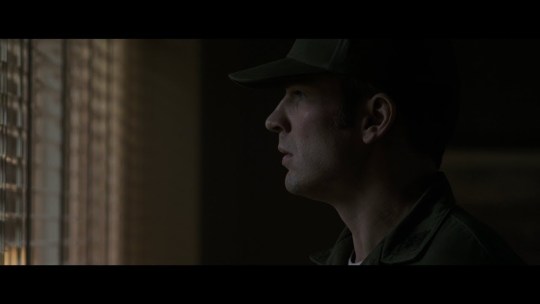
It’s impossible to infer a causality loop here in the same way as we saw in PoA. In PoA, there is a payoff for every single unusual or weird moment the story presents the audience before and after the use of time travel but this is something that’s completely absent from Endgame’s narrative. Steve himself doesn’t even vocalise a desire to go back in time at any point in EG nor at any point during the other films he appears in. In fact, when questioned by Tony Stark about the possibility of ‘going home’ in Avengers: Age of Ulton, he says, “The guy who wanted all that went in the ice 75 years ago. I think someone else came out.” While it is indicative of his unhappiness in the modern-day, it does indicate a level of acceptance of the fact that this is his life and he has to make his peace with it. He’s taken what Peggy said in CA:TWS on board. He’s starting over and moving on.
With time travel, and Steve choosing to stay in the past came the fan theory that one of the pallbearers carrying Peggy’s casket in CA:CW is Old Man Steve, her husband. When presented with this fan theory, writer Christopher Markus said during an interview with the LA Times at SDCC 2019,
“I would very much like that. There is no set explanation for Cap’s time travel . . .I mean, we’ve had public disagreements with [directors Anthony and Joe Russo] about what it [time travel] necessarily means, but I love the idea of there being two Steve Rogers in the timeline. One who lived a long life with Peggy and is in the background of that funeral scene watching his young self carry his wife’s coffin up. Not just for the time travel mumbo jumbo of it, but for the just weird, personal pain and satisfaction that would be happening between two Steve Rogers there. I kind of love it.” [emphasis mine]
This shows that unlike in PoA there was no intention of creating a causality loop prior to Markus writing EG with his writing partner Stephen McFeely. In fact, it makes clear that the actual rules of time travel were in contention and that even those making the film didn’t have a unified idea of what they wanted to create in the first place. The fact that there is confusion surrounding EG's time travel is due to the fact that the people behind it, didn't seem to know what they were writing or consider the consequences of it.
What all of this shows is that an argument of a PoA style causality loop doesn’t hold water. The film doesn’t support it, nor do any of the previous films, because there aren’t any indicators for the audience to latch onto. There is no moment of the rock breaking the jar, or the patronus chasing away the dementors, no moment where that the audience is told to hold into this information for later because there’s some timey wimey stuff going on. Ultimately, when examined, there is no set-up for a causality loop that supports the theory he was always supposed to go back and be Peggy’s husband, particularly when examined against a film that successfully lays it out from the start.
Right, the more academic (lol) part of this post is done. I just want to address one more TikTok that bothered me because I have opinions and MCU Captain America is my Mastermind specialist subject.
The TL;DR of this one was that Steve’s ending made sense because he got out of the fight and was at peace and that that has been the ultimate goal of his character arc. This person argued that Steve used the Avengers to distract himself from the fact that he’s this man out of time and he can’t find peace without a fight which to some extent, I agree with. I don’t deny that that is a major driving force to his story. We see that in Age of Ultron with his WandaNightmare. I don’t deny that that is key to his character. However, this creator then made a comment at the end of this video to the tune of, ‘bUt BuCkY iS hIs StOrY aRc’ and tried to play it off like this wasn’t true or that people were wrong to think that this is the case.
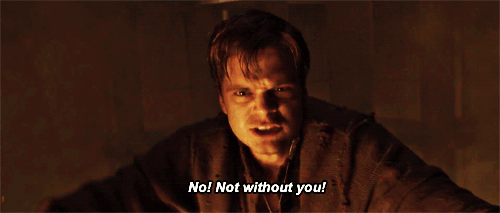
These two things aren’t mutually exclusive. They’re both true. They’re intertwined. But you cannot say that Bucky Barnes isn’t at the heart of Steve Rogers’ story. Bucky was the catalyst for every single one of Steve’s movies. He becomes CA because of Bucky. He goes against SHIELD because of Bucky. He defies 107 countries and the Sokovia Accords because of Bucky. You take Bucky out of the equation and what do you have? What happens in those films if you take Bucky Barnes out of the equation? Viewing it objectively, and even without shipper goggles on, you simply cannot sit there and claim that Bucky Barnes isn't a defining component to Steve’s story. Steve Rogers is motivated by Bucky Barnes. Steve Rogers is motivated by the depth of their relationship and the fact that Bucky Barnes is one of the few things connecting his new present to his old life.
You can definitely see the fact that Steve is uncomfortable in the modern world. He doesn’t address any of his trauma but he still attempts to move on. However, if they wanted him getting out of the fight and finding life as a civilian to be the natural end to his story arc then there was a way to do it which didn’t require him going back to Peggy. It would have been a better and more satisfying ending if he’d actively chosen to retire because I often see the argument that him going back to Peggy is him finally allowing him to be selfish after shouldering so much over the past decade or more. If Steve chose to retire and put himself first, then that sends a better message. He’s still getting the chance to ‘be selfish’ but he’s not throwing the life he’s built away. At this point in EG, he’s spent a huge portion of his adult life in the modern-day. This isn’t the future for him anymore, it’s the present and he’s lived a life and made real connections with people. The MCU does a piss poor job of showing the interpersonal relationships between the Avengers but he is at least shown to be friends with Sam, Nat, and Bucky.
But he goes back to a delusion. Or an idea of something that was never his in the first place.
When I see people make these videos and share their opinions, I can see their points but it’s like they’re taking EG on its own when that's impossible. Endgame only ‘works’ if you have the context of 10 years’ worth of films. You have to at least be somewhat familiar with the characters, who they are and what they’ve done up until now to be able to make sense of it.
However, in saying that, they wrote and filmed the movie in a way to make you think you didn’t have to take into account anything you’ve seen in the past ten years. If you only watch Endgame, you only see a grieving man mourning the love he never had. You see a man, regretful that he didn’t get to be with woman he loved. So at the end, of course it would make sense that he goes back to her. But you can only do that if you completely divorce Endgame from its ten-year canon and in a franchise like this where they make a big deal about everything being interconnected, it simply doesn’t work. Steve’s story arc in Endgame is incongruous to the narrative arc we’ve been presented in previous films.
Ultimately, Endgame is a movie you’re supposed to watch once and then not think about again. It’s made for that first viewing when everything is shocking and exciting because if you stop to think about it even a little bit, it falls apart under scrutiny.
Finally, I think that the downfall of a lot of these ‘Steve’s ending makes sense’ posts is that made by people who are most certainly MCU fans but not Steve Rogers fans and it shows.
#in this essay i will#endgame wank#anti endgame#for the filters#steve rogers#my writing#because this i didn't spend my afternoon on this for nothing#marvel#stevie#angelblue007
622 notes
·
View notes